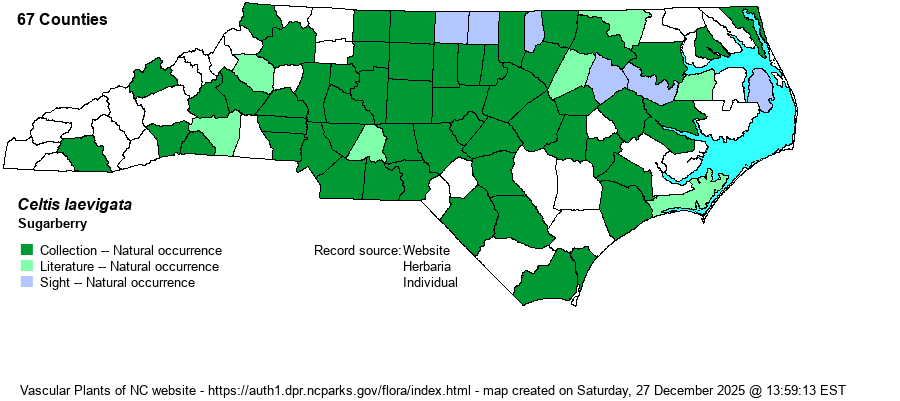| Section 6 » Order Urticales » Family Cannabaceae |
Show/Hide Synonym
| taxonName | relationship | relatedTaxonName | relatedTaxonRefText | relComments |
|---|
| Celtis laevigata | < | Celtis laevigata | Gleason and Cronquist (1991) | | | Celtis laevigata | < | Celtis laevigata | Flora of North America (1993b, 1997, 2000, 2002a, 2002b, 2003a, 2004b, 2005, 2006a, 2006b, 2006c, 2007a, 2009, 2010) | | | Celtis laevigata | < | Celtis laevigata | Gleason (1952) | | | Celtis laevigata | < | Celtis laevigata | Godfrey and Wooten (1979, 1981) | | | Celtis laevigata | < | Celtis laevigata | | | | Celtis laevigata | < | Celtis laevigata | Radford, Ahles, and Bell (1968) | | | Celtis laevigata | < | Celtis laevigata | | | | Celtis laevigata | < | Celtis laevigata | Flora of Virginia | | | Celtis laevigata | < | Celtis laevigata | Wofford (1989) | | | Celtis laevigata | < | Celtis laevigata | Wunderlin & Hansen Flora of Florida (3) | | | Celtis laevigata | = | Celtis laevigata var. laevigata | Fernald (1950) | | | Celtis laevigata | = | Celtis laevigata var. laevigata | Todzia in Kubitzki, Rohwer, & Bittrich (1993). Key based in part on Mo. | | | Celtis laevigata | = | Celtis mississippiensis | Small (1933, 1938) | | | Source: Weakley's Flora |
|
| Author | Willdenow | |
| Distribution | Essentially throughout the Piedmont and Coastal Plain, though likely absent in a few eastern counties in the latter province; present only at low elevations in the Mountains. However, with the recent lifting of C. smallii to full species status by some authors, some to many of these specimens might refer to this very similar species.
This is primarily a Southern species ranging north only to MD and KS, south to the Gulf Coast from FL to TX.
| |
| Abundance | Fairly common to common in the central and eastern Piedmont, and along brownwater floodplains in the Coastal Plain. Mostly quite rare in the foothills and low Mountains, as well as in the Coastal Plain away from brownwater floodplains. | |
| Habitat | This is a characteristic species of brownwater floodplain riverbanks and natural levees, growing mostly close to a river or stream bank. Away from rich floodplains, it grows on rich soil of mesic/upland forests, but it is not to be intentionally searched for in such habitats. Even so, when in uplands, care must be taken to separate it from the several other Celtis species. |
| Phenology | Flowers in April and May; fruits from August to October. | |
| Identification | This is a familiar medium to large deciduous tree, often growing to 80-90 feet tall. It can usually be identified solely by its bark, which is mostly smooth and light gray, but has numerous warty/cork-like projections, unlike the bark of any other floodplain tree. The leaves are alternate, lanceolate and with slightly serrated margins, reaching about 4 inches long, with a tapering tip. These leaves are narrower than on two other Celtis species -- C. occidentalis and C. pumila. Seldom needed for identification are the orange-red drupes that appear in the late summer and fall. Note that C. smallii has recently been considered as a good species by a few references and is very similar to C. laevigata; see that species for more information. | |
| Taxonomic Comments | Decades ago, there was a variety of this species named as C. laevigata var. smallii. Nearly all recent references had not included varieties for the species, but Weakley (2018) now has this taxon split off as a good species -- C. smallii. See this reference for distinguishing characters.
| |
| Other Common Name(s) | Southern Hackberry, Sugar Hackberry | |
| State Rank | S5 | |
| Global Rank | G5 | |
| State Status | | |
| US Status | | |
| USACE-agcp | FACW link |
| USACE-emp | FACW link |

